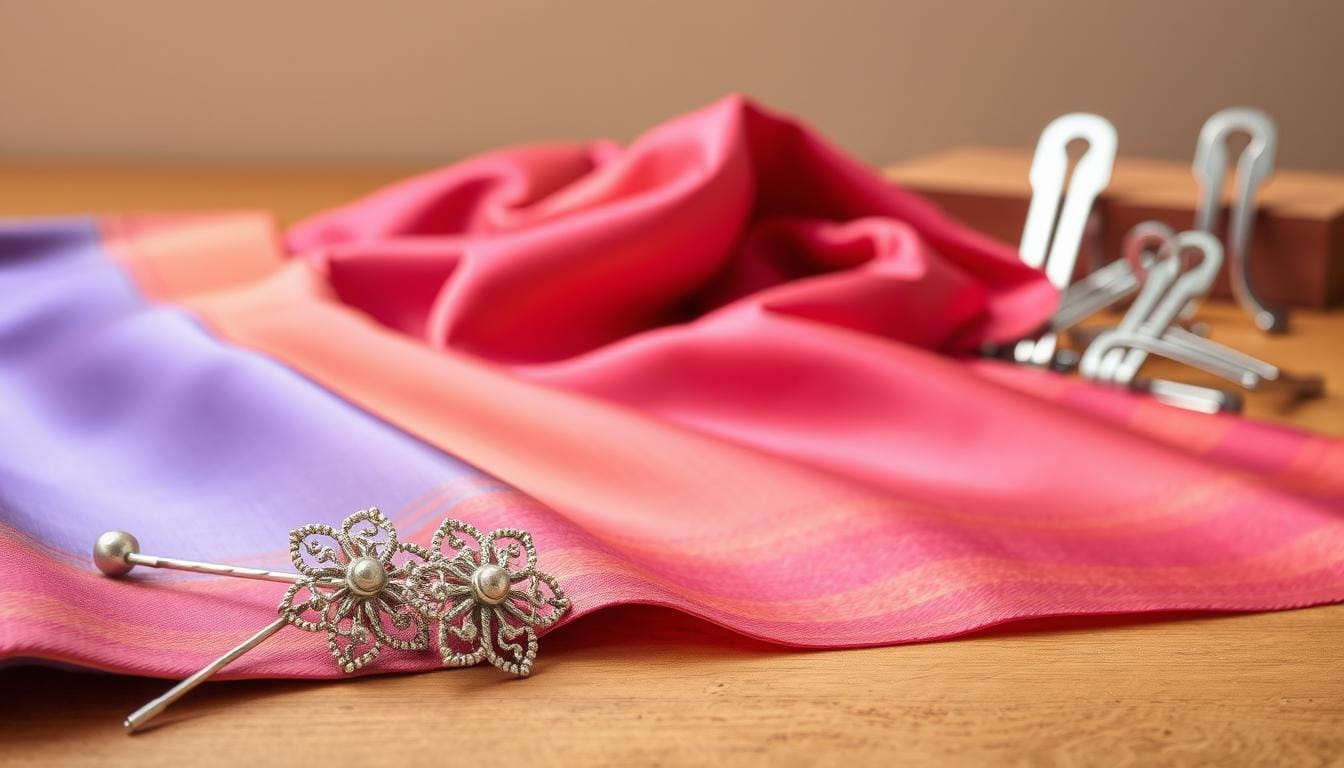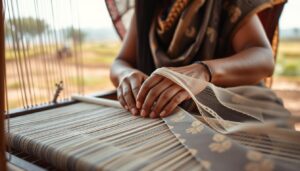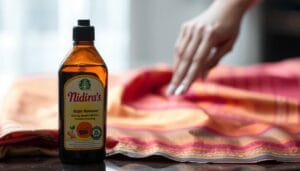Modern & Traditional Ways to Drape Sarees
The art of draping a saree is a timeless tradition in Indian culture, reflecting the rich heritage and diversity of the country. Silk sarees, in particular, are revered for their elegance and sophistication.
Draping a saree is not just about wrapping fabric around the body; it’s an art form that requires skill, patience, and practice. With various styles and techniques to master, it’s no wonder that silk saree draping has become a beloved tradition.
From the classic Nivi drape to the elegant Maharashtrian style, there are numerous ways to drape a saree. Whether you’re a seasoned pro or a beginner, this article will guide you through the world of silk saree draping, exploring both modern and traditional methods.
Key Takeaways
- Understanding the basics of saree draping
- Exploring traditional and modern draping styles
- Tips for mastering the art of silk saree draping
- Discovering the cultural significance of sarees in India
- Learning how to choose the right saree for any occasion
The Rich Heritage of Silk Sarees in Indian Culture
Silk sarees have been an integral part of Indian culture for centuries, symbolizing tradition and elegance. The significance of these garments extends beyond their aesthetic appeal, representing a rich cultural heritage that has been passed down through generations.
The Cultural Significance of Silk Sarees
Silk sarees hold a revered position in Indian culture, often being worn during significant events and ceremonies. They are considered a symbol of grace and sophistication, with their intricate designs and patterns telling stories of regional traditions and mythological tales. The cultural significance of these sarees is deeply rooted in their ability to evoke a sense of nostalgia and connection to one’s heritage.
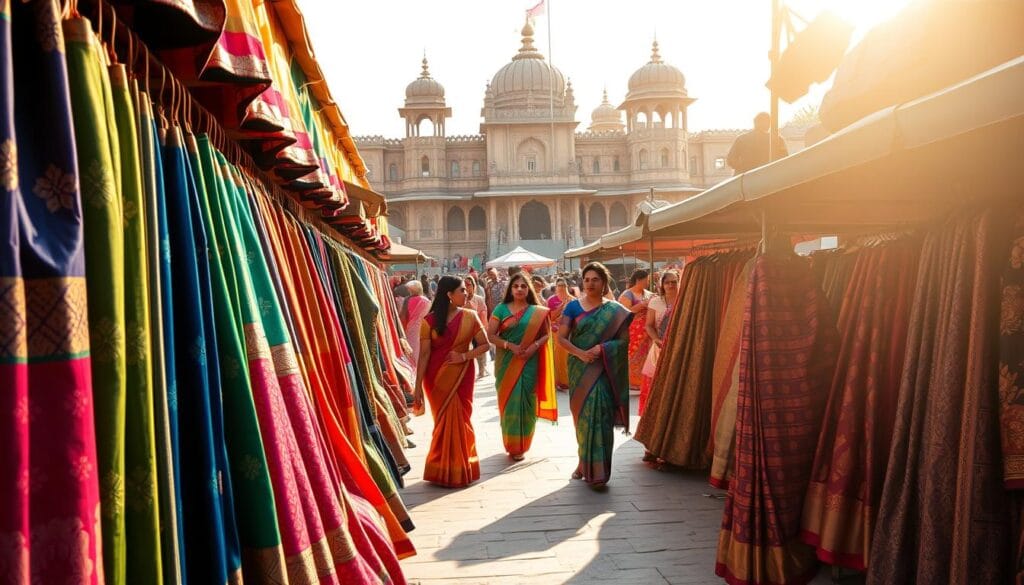
Evolution of Saree Draping Through the Ages
The art of draping a saree has evolved significantly over time, influenced by various cultural and social factors. From the traditional Nivi drape to more contemporary styles, the versatility of the saree has allowed it to adapt to changing fashion trends while retaining its cultural essence. This evolution is a testament to the dynamic nature of Indian fashion, which continues to innovate while respecting its heritage.
Popular Types of Silk Sarees Across India
India is home to a diverse array of silk sarees, each region offering its unique varieties. Some of the most renowned types include:
Kanchipuram, Banarasi, and Mysore Silks
- Kanchipuram silk sarees are known for their vibrant colors and intricate zari work.
- Banarasi sarees are celebrated for their rich brocade and opulent designs.
- Mysore silk sarees are prized for their soft texture and elegant motifs.
Paithani, Patola, and Pochampally Varieties
| Type | Characteristics | Region |
| Paithani | Vibrant colors, intricate designs | Maharashtra |
| Patola | Double-ikat weaving, geometric patterns | Gujarat |
| Pochampally | Ikat patterns, geometric designs | Telangana |
These silk sarees not only reflect the rich cultural diversity of India but also highlight the exceptional craftsmanship of its artisans. Each type has its unique story, contributing to the rich tapestry of Indian saree culture.
Buy here: Pink Kanjeevaram Silk Saree with Zari Border
Essential Preparations Before Draping a Silk Saree
The art of draping a silk saree starts long before you begin to drape. It involves a series of preparations that ensure your saree looks its best and drapes elegantly on your body.
Selecting the Right Petticoat and Blouse
Choosing the right petticoat and blouse is crucial for a flawless saree drape. The petticoat should be comfortable and match the color of your saree or blouse. The blouse, on the other hand, should fit well and complement the saree’s design and color. A well-fitted blouse can make a significant difference in how the saree drapes on you.
Necessary Accessories for Secure Draping
To ensure your saree stays in place, you’ll need a few essential accessories.
Safety Pins, Saree Belts, and Fall Attachments
Safety pins are a must-have for securing the saree pleats, while saree belts can add a decorative touch and help keep the saree in place. Fall attachments can be used to secure the saree’s fall, preventing it from slipping or coming undone.
Pre-Draping Fabric Care Tips
Taking care of your silk fabric before draping is vital. This includes ironing the saree to remove any wrinkles and creases.
Ironing Techniques for Different Silk Types
Different types of silk may require different ironing techniques. For instance, Charmeuse silk should be ironed on the reverse side with a low-temperature setting, while Dupioni silk can be ironed with a slightly higher temperature. Always check the care label for specific instructions.
By following these preparation steps, you’ll be able to drape your silk saree with ease and confidence, ensuring it looks beautiful and stays in place throughout the day.
The Classic Nivi Drape: Mastering the Basics
The Nivi drape, a staple in Indian attire, is both versatile and elegant. This classic style has been a favorite among saree enthusiasts for generations, and mastering it can elevate your saree game significantly.
Step-by-Step Guide to the Nivi Drape
To achieve a flawless Nivi drape, start by draping the saree around your waist, ensuring the pallu is on your left shoulder. Secure the saree with a few pins at the waist to prevent it from coming undone.
Next, create the pleats by folding the fabric into even sections. It’s crucial to maintain uniformity in the pleats to achieve a neat and tidy look.
Regional Variations of the Nivi Style
While the Nivi drape is popular across India, different regions have their own twists. For instance, in some parts of South India, the Nivi drape is worn with a slightly different pallu style, adding a unique touch to the classic look.
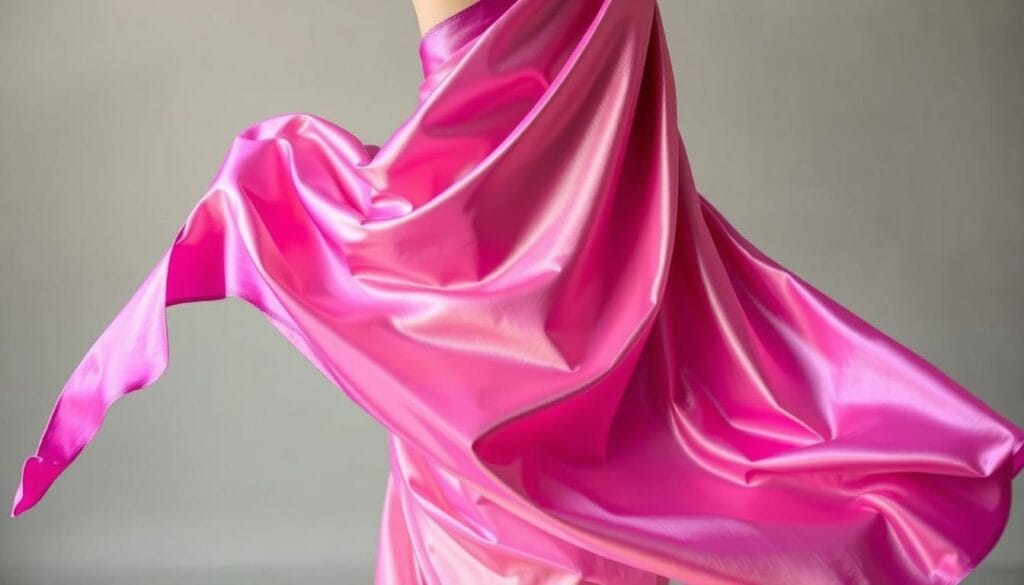
Common Mistakes to Avoid
One of the most common issues faced while draping a saree is managing the pleats. Pleating problems can be mitigated by ensuring the fabric is smooth and evenly folded.
Pleating Problems and Solutions
- Uneven pleats: Ensure the fabric is evenly folded and pinned securely.
- Pleats coming undone: Use a few extra pins to secure the pleats in place.
Pallu Management Techniques
Managing the pallu is another critical aspect of the Nivi drape. Adjust the pallu to fall elegantly over your shoulder, and secure it with a pin if necessary.
By following these steps and tips, you can master the classic Nivi drape and enjoy a timeless, elegant look.
Traditional Regional Draping Styles
Traditional saree draping styles in India are as diverse as the country’s cultural landscape. Each region has its unique way of draping a saree, reflecting the local culture, history, and traditions.
The art of saree draping is not just about wearing a piece of cloth; it’s about showcasing one’s heritage and identity. Let’s explore some of the most popular traditional regional draping styles.
Bengali Atpoure Style
The Bengali Atpoure style is a traditional way of draping sarees that originated in Bengal. Characterized by the saree being draped in a way that the pallu (the decorative end of the saree) is worn on the right shoulder, this style exudes elegance and sophistication.
Gujarati Seedha Pallu Method
The Gujarati Seedha Pallu method is a simple yet stylish way of draping a saree. In this style, the pallu is draped straight down the back, giving a clean and minimalist look. This style is popular among women in Gujarat and is often worn during traditional occasions.
South Indian Madisar Technique
The South Indian Madisar technique is a traditional draping style predominantly worn by Brahmin women in Tamil Nadu. This style involves draping the saree in a specific way that creates a neat and modest look, often paired with traditional jewelry.
Maharashtrian Nauvari Drape
The Maharashtrian Nauvari drape, also known as the nine-yard saree, is a traditional style from Maharashtra. This style involves draping a nine-yard saree in a way that it is both elegant and comfortable. The Nauvari saree is known for its unique draping style, which is both modest and stylish.
The Nine-Yard Wonder: Step-by-Step Guide
Draping a Nauvari saree is an art that requires some practice. Here’s a simplified step-by-step guide:
- Start by tucking the saree into your petticoat, ensuring it’s evenly spread.
- Drape the saree over your shoulder, creating a neat pleat.
- Continue draping the saree around your body, tucking it into your petticoat as you go.
- Finish by draping the pallu over your shoulder, adjusting it to your desired length.
| Draping Style | Region | Characteristics |
| Bengali Atpoure | Bengal | Pallu worn on the right shoulder |
| Gujarati Seedha Pallu | Gujarat | Pallu draped straight down the back |
| South Indian Madisar | Tamil Nadu | Neat and modest look |
| Maharashtrian Nauvari | Maharashtra | Nine-yard saree, elegant and comfortable |
Styling Silk: Modern & Traditional Ways to Drape Sarees
Modern saree draping is a fusion of heritage and innovation, offering endless possibilities for the fashion-conscious. As we explore the various techniques and styles, it’s clear that the saree remains a versatile and beloved garment in Indian fashion.
Fusion Draping Techniques
The world of saree draping is witnessing a beautiful blend of traditional and modern styles. Fusion draping techniques are gaining popularity, allowing wearers to experiment with new looks while retaining the essence of classic styles.
The Butterfly Drape
The Butterfly Drape is a contemporary technique that adds a touch of elegance to the traditional saree. This style involves draping the pallu in a way that resembles butterfly wings, creating a unique and eye-catching effect.
The Dhoti-Style Wrap
Another innovative approach is the Dhoti-Style Wrap, which combines the comfort of a dhoti with the grace of a saree. This style is particularly popular among younger generations who seek to blend traditional attire with modern comfort.
Contemporary Adaptations of Classic Styles
While traditional draping styles continue to be revered, contemporary adaptations offer a fresh perspective. Designers and saree enthusiasts are reimagining classic styles, incorporating modern elements such as:
- Experimental fabrics and textures
- Innovative draping patterns
- Contemporary blouse designs
Celebrity-Inspired Modern Drapes
Celebrities often set trends in saree styling, inspiring fans with their bold choices. Bollywood Trends in Saree Styling are particularly influential, with many fans emulating the styles worn by their favorite stars on the red carpet.
Bollywood Trends in Saree Styling
Bollywood celebrities are known for their stunning sarees, often featuring intricate designs, luxurious fabrics, and innovative draping styles. These trends trickle down to the general public, influencing how sarees are styled and perceived.
Body-Type Specific Draping Tips
The right saree draping technique can enhance your natural beauty and boost confidence. Different body types can pull off various saree styles, and understanding your body shape is key to mastering the perfect drape.
Styles for Petite Frames
For petite women, it’s all about creating a balanced look. Opt for a Nivi drape or a simple Gujarati style that doesn’t overwhelm the frame. Avoid heavy embellishments and bulky fabrics that can make you appear even shorter.
- Choose lightweight fabrics
- Opt for simple draping styles
- Avoid heavy embellishments
- Consider a shorter pallu
Flattering Drapes for Curvy Figures
Curvy women can accentuate their curves with the right saree style. A Maharashtrian Nauvari drape or a Bengali Atpoure style can be very flattering. Emphasize your waist with a defined blouse and petticoat combination.
- Highlight your waist with a fitted blouse
- Choose a saree that creates a balanced silhouette
- Avoid too much volume on the hips
Draping Tips for Tall Women
Tall women have the advantage of being able to pull off a variety of saree styles. Experiment with fusion draping techniques or a dramatic South Indian Madisar style. Don’t be afraid to try out different pallu styles and lengths.
- Try out different pallu styles
- Experiment with fusion draping
- Play with different lengths and volumes
Creating Balance for Different Body Shapes
Regardless of your body type, creating balance is key. Use saree styling tips to your advantage by balancing volume, texture, and embellishments. For instance, pair a heavily embellished saree with a simple blouse and minimal jewelry.
Troubleshooting Common Silk Saree Draping Issues
Whether you’re a seasoned saree wearer or a beginner, dealing with draping issues is a common experience. Draping a silk saree can sometimes be challenging, with issues like slippage and managing heavy fabrics. This section will offer practical solutions to these common problems.
Preventing Saree Slippage
One of the most frustrating issues while draping a silk saree is slippage. To prevent this, ensure you’re wearing a well-fitted petticoat and use silk fabric care products that help keep the saree in place. Using double-sided tape or safety pins discreetly can also secure the saree.
Managing Heavy Silk Fabrics
Heavy silk fabrics can be daunting to drape. To manage them, start by using a sturdy petticoat that can support the weight. You can also consider using a saree grip or a non-slip underskirt to keep the fabric from slipping.
Quick Fixes for Draping Emergencies
Even with the best preparations, emergencies can happen. For quick fixes, keep a small kit with essentials like safety pins, double-sided tape, and a needle with thread. On-the-go repair techniques can save the day.
On-the-Go Repair Techniques
For a quick fix, you can use a simple running stitch to secure loose ends or re-pin the saree. Practicing these techniques can make you more confident in handling draping emergencies.
Accessorizing Your Silk Saree
Elevate your silk saree look with the right accessories. Accessorizing is an art that can enhance the beauty of your silk saree, making it a stunning ensemble for any occasion. The key is to balance your saree with complementary accessories that reflect your personal style.
Jewelry Pairings for Different Silk Varieties
Choosing the right jewelry can significantly impact your overall look. For instance, a heavy Kanjeevaram saree pairs well with intricate, traditional jewelry, while a lightweight Georgette saree can be accessorized with delicate, contemporary pieces.
Traditional vs. Contemporary Jewelry Choices
Traditional jewelry like Kundan or Polki works well with classic silk sarees, adding a touch of heritage. On the other hand, contemporary jewelry with minimalist designs can modernize your look, making it suitable for semi-formal events.
Selecting the Perfect Blouse Design
The blouse is a crucial component of your saree look. For a Banarasi saree, a heavily embroidered blouse can complement its richness, while a simple, elegant blouse is more suitable for a Chiffon saree. The key is to balance the saree’s embellishments with your blouse design.
Footwear and Handbag Coordination
Footwear and handbags are the finishing touches to your outfit. For a traditional look, juttis or mojari can be a great choice, while stilettos can add a modern twist. Your handbag should complement your footwear; for example, a potli bag goes well with traditional juttis.
By thoughtfully accessorizing your silk saree, you can create a look that is both elegant and uniquely yours. Whether you’re attending a wedding or a formal event, the right accessories can make all the difference.
Conclusion: Embracing Your Personal Silk Saree Style
As we conclude our journey through the world of silk sarees, it’s clear that the art of draping is not just about following traditional methods, but also about embracing your personal style. Silk saree draping is an integral part of Indian saree culture, reflecting the country’s rich heritage and diversity.
From the classic Nivi drape to modern fusion styles, the versatility of silk sarees allows you to experiment and find what works best for you. Whether you’re attending a traditional wedding or a contemporary social gathering, your silk saree is sure to make a statement.
By mastering various draping techniques and accessorizing with confidence, you can unlock the full potential of your silk saree. So, go ahead and explore the world of Indian saree culture, and make the traditional art of silk saree draping your own.
FAQ
What are the different types of silk sarees?
There are various types of silk sarees, including Kanchipuram, Banarasi, Mysore, Paithani, Patola, and Pochampally, each with its unique characteristics and cultural significance.
How do I choose the right petticoat and blouse for my saree?
Selecting the right petticoat and blouse is crucial for a comfortable and secure drape. Consider the color, fabric, and style of your saree when making your selection.
What are some common mistakes to avoid when draping a saree?
Common mistakes include uneven pleating, incorrect pallu management, and not securing the saree properly. Practice and patience can help you avoid these mistakes.
How can I prevent saree slippage?
To prevent saree slippage, use safety pins, saree belts, or fall attachments. You can also try adjusting the drape or using a non-slip underskirt.
What are some modern draping techniques I can try?
You can try fusion draping techniques like the butterfly drape or dhoti-style wrap. Contemporary adaptations of classic styles and celebrity-inspired modern drapes are also great options.
How do I style my silk saree with jewelry and accessories?
Consider the type of silk saree, its color, and the occasion when choosing jewelry and accessories. Traditional or contemporary jewelry choices, a well-designed blouse, and coordinated footwear and handbags can elevate your overall look.
What are some body-type specific draping tips?
Different body types can pull off various saree draping styles. For example, petite frames can opt for simpler drapes, while curvy figures can try drapes that create a balanced silhouette.
How do I care for my silk saree before draping?
Ironing techniques vary depending on the type of silk. Generally, it’s best to iron your saree while it’s still slightly damp, using a low heat setting and a pressing cloth to prevent damage.
What are some quick fixes for draping emergencies?
For on-the-go repair techniques, you can use safety pins, fabric tape, or a bobby pin to secure loose threads or adjust the drape.
